Home
Jars
Bottles Vases & Planters
Miniature Vases & Boxes
Tea Ware & Tea
Bowls Plates Dinnerware Sets
Incense Burners & Trays
Chopsticks & Rests
Music & Lacquered Boxes
Dolls & Figurines
Fans Mirrors Bookmarks
Masks No-ri-gae & Lamps
Celadon Pendants
Screens Souvenirs Phone Fobs
Furniture and Chests
Paintings
Handmade Only
About The Art of Korea
| |
Origins
Hidden between the demise of celadon and the
rise in popularity of white porcelain ware, Bun-cheong enjoyed about a one
hundred year reign as the most common type of pottery, and was used by both the
aristocracy and commoners throughout Korea.
The invention of Bun-cheong came about slowly more or less as an
evolution of the
Koryo Dynasty (918-1392AD) celadon that preceded, it rather than appearing
spontaneously and, as with
most of the developments in the Korean arts, forces outside of Korea played an
important role in its creation.
Celadon production flourished during the height of the Koryo
Dynasty where high quality vessels were needed for Buddhist rituals and by the
royal court. But the Mongol invasions into Korea which began in
1231, and the subsequent decline of the Buddhist culture which had led to Korea's
advancements in celadon production, began to take their toll as the populace
focused on survival rather than art. The quality of the celadon began to suffer
and more emphasis was placed on practical vessels that could be used by all,
rather than objects of beauty to be used by the aristocracy and in Buddhist
rituals.
|
From the
beginning of the invasions and for the next 150 years or so, the production of
vessels shifted from high grade celadon, to rather lower grade wares while still
maintaining some of the design features of celadon. The new pottery which began to emerge at this time was called Bun-cheong
and was made with a the same clay as was used for celadon, but of a noticeably
coarser grade.
During this transition period, attempts were made to dress
up the new wares and make them as attractive as celadon had been by
painting them with a celadon glaze which rendered a greenish tone to the wares. While the result was unique and attractive,
it could not compare with the beauty of celadon.
By the beginning of the Yi Dynasty (1392-1910) the production of
celadon had all but died out and the art of producing it was lost. Therefore, Bun-cheong
was the predominant pottery of this period and it continued to be the widely
produced and used for the next 100 years. |
|
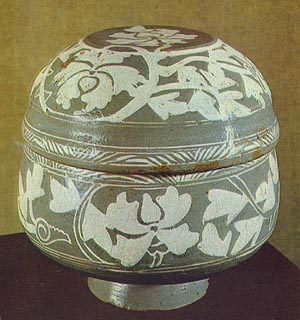 |
Transitional period, Bun-cheong ware with celadon
glaze; rice bowl with lid. Late 14th to early 15th century.
Chun Hyung-pil Collection
|
|
As mentioned above, Bun-cheong was made with a coarser clay than
celadon and its techniques for production were a bit coarse as well. Earlier Bun-cheong
from the transitional period used a celadon glaze, and was often inlaid like celadon, but
later a
decoration technique unique to Bun-cheong was developed in which the the patterns
were formed with wood block stamps, or etched on, and
then the pieces were covered with a white slip. The slip was either painted by
hand, or the entire piece was dipped in a tray of slip after which the excess
slip was scraped off leaving it behind in the stamped or etched patterns.
Unfortunately, not all the slip could be removed this way and it often left a
whitish residue over the whole piece, or at the very least unwanted slip
outside of the patterns. Alternately, the white slip was brushed on using a
rough brush in a carefree fashion and, though not particularly precise, this
method was quite popular both in Korea, and out. In short, Bun-cheong was of a rougher finish than
celadon both due to the coarser clay and the level of craftsmanship.
Many different patterns were used to decorate Bun-cheong
but among the most common were the "rope curtain pattern", and pattern of
stamped chrysanthemum heads, or plain dots.
|
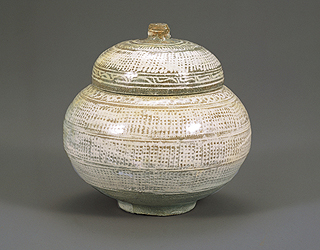 |
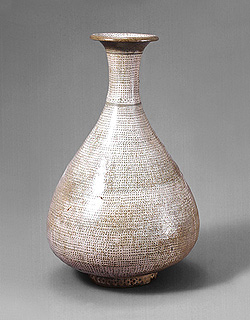 |
Bun-cheong bowl with lid and a rope
curtain
pattern. Mid 15th century.
Ho-Am Art Museum
|
Bun-cheong wine bottle with a stamped ring of
chrysanthemums above
the band on the neck and on the base, and a rope curtain pattern
over the rest of the body. 15th century. National Museum of Korea
|
As with the introduction of Bun-cheong,
its decline was also brought about by foreign influence. The Japanese invasions
into Korea by Toyotomi Hideyoshi, which began in 1592, razed the country of its
cultural treasures; a great many of the temples, palaces and other culturally
significant structures were destroyed by the Japanese and the populace was
either displaced or killed. Many of the pottery kilns that had been operating
throughout the country, were also destroyed or shut down by the invasions and
the potters themselves were taken back to Japan to bolster the Japanese pottery
industry that was to become so famous in later years.
In the years prior to the invasions, the Korean potters had
been improving the craftsmanship of Bun-cheong wares and developing white
porcelain as well. But the loss of many of the Korean potters dealt such a
severe blow to the
development of Korean pottery that after the end of the Japanese invasions in 1598, the Korean
ceramics industry never recovered completely, and though the production of white
porcelain did re-appear, the production of Bun-cheong did not. While its
manufacturing techniques were considered to be "lost", it is more
likely that the emphasis simply shifted to the production of superior white
porcelain wares and that the inferior Bun-cheong wares were no longer
needed.
The years immediately following the Korean war (1950-1953)
left little time for cultural reminiscing, but starting in about 1955, the same
time that Korean artisans began to rebuild the celadon industry, they also
re-kindled the production of Bun-cheong.
The transitional period of Bun-cheong in which celadon
glazes or celadon style designs were used, is not well represented in modern Bun-cheong. Most modern Bun-cheong still uses the coarser clay it was
originally created with and incorporates many of the design features used during
the height of Bun-cheong production; most notably the rope curtain
pattern, and stamped chrysanthemums and dots. Its finish is generally a brownish
glaze which often has a dark green tint, and its stamped patterns are filled
with a white slip. Not as culturally significant as celadon, it is produced by
fewer artists and in limited quantities today.
|
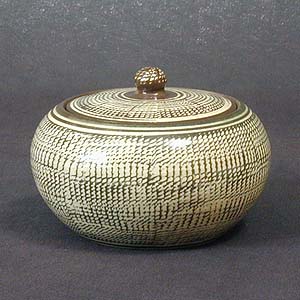 |
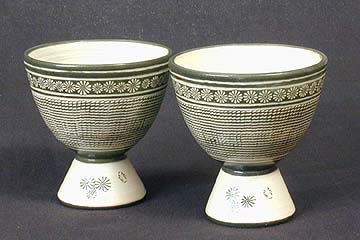 |
Modern celadon jar with lid and rope curtain pattern.
Korean-Arts' item BCJ008
|
Modern celadon cups with stamped chrysanthemum pattern
around the top of the cup body, and a rope curtain pattern over
the remainder of the body. Korean-Arts' item BCCS011
|
|
